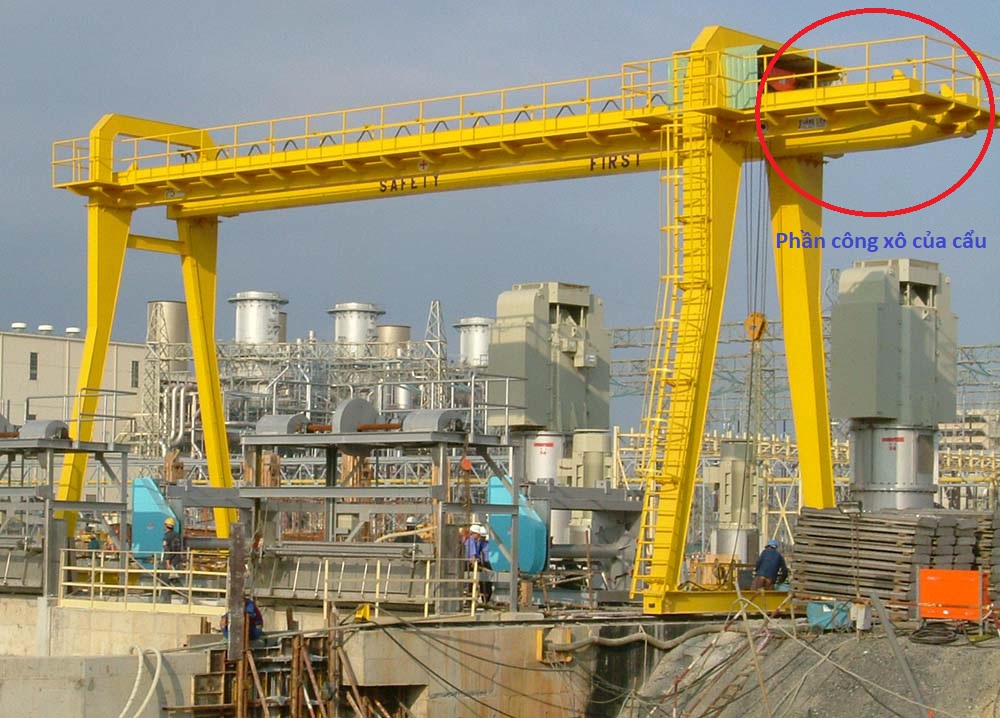The gantry crane is one of the most crucial pieces of lifting equipment, serving as the backbone for numerous industries, from manufacturing and construction to logistics and seaport operations. With the capability to handle oversized and overweight cargo, the gantry crane is an indispensable solution that helps businesses optimize efficiency, accelerate loading/unloading speeds, and ensure operational safety.
This article will provide a comprehensive A-to-Z overview of gantry cranes, covering their basic structure, common classifications, operating principles, and practical applications.
1. Gantry Crane Structure: Core Components
Essentially, a gantry crane is a variation of an overhead crane, designed to operate independently without relying on a building’s support runway system. Its structure resembles a sturdy, movable gate.
A standard gantry crane consists of the following main parts:
-
Main Girder: This is the most critical load-bearing structure. Depending on the load capacity and span, the main girder can be a single girder gantry crane (one girder) or a double girder gantry crane (two parallel girders). Double girders are typically chosen for tasks requiring heavy load capacities and high stability.
-
Gantry Legs (Supports): These support the entire main girder system and the load. The legs are often designed in an A-frame shape to enhance stability and distribute forces evenly.
-
Hoisting Mechanism (Hoist or Trolley): This is the “heart” of the gantry crane, responsible for lifting and lowering goods. This mechanism includes the hoisting motor, gearbox, cable drum, and hook, and it travels along the main girder.
-
Traveling Mechanism: This allows the entire gantry crane to move along the working area. The system can feature steel wheels on rails (RMG – Rail-Mounted Gantry crane) for high precision, or rubber tires (RTG – Rubber-Tired Gantry crane) for superior flexibility.
-
Electrical System and Control Cabinet: This supplies power and controls all operations of the equipment. The system includes the electrical cabinet, an inverter (which helps control motor speed smoothly), a power cable system, and safety devices.
-
Control Methods: The operator can control the gantry crane through various methods: a high-mounted operator’s cabin, remote control, or a wired pendant control.

2. Common Types of Gantry Cranes Today
Gantry cranes come in a wide variety of designs to meet different operational needs. Below are the most common classification methods:
Classification by Structure and Design:
| Gantry Crane Type | Characteristics |
| Single Girder Gantry Crane | Features one main girder, suitable for light to medium loads (1-20 tons), with lower investment costs. |
| Double Girder Gantry Crane | Features two main girders, providing excellent stability and the ability to lift very heavy loads (up to 500 tons). |
| Semi-Gantry Crane | Has only one set of support legs, while the other side travels on a runway beam attached to a factory wall. Highly space-efficient. |
| Trestle Gantry Crane | Features a high, narrow leg structure, commonly used in hydroelectric power plants to lift and lower dam gates. |
| Gantry Crane with/without Cantilever | A cantilever is the part of the main girder that extends beyond the crane legs, helping to expand the working area without moving the entire structure. |
Classification by Traveling Mechanism and Application:
-
RTG Crane (Rubber-Tired Gantry Crane): Specialized for stacking and moving containers in port yards and ICDs. Highly mobile.
-
RMG Crane (Rail-Mounted Gantry Crane): Also used for container handling but moves on fixed rails. It is powered by the electrical grid, making it environmentally friendly and suitable for automation.
-
Manual Gantry Crane: A small, low-capacity type that is moved by human force, used in small workshops.
-
Shipbuilding Gantry Crane: A crane of enormous size and lifting capacity, specifically used for assembling large ship hull modules.
(Suggestion: Insert images of different gantry crane types. Alt text: “Gantry crane classification: single girder gantry crane, RTG crane, and semi-gantry crane”)
3. Operating Principle and Safety Features
Basic Operating Principle
A gantry crane operates based on the coordination of electric motors. When the operator gives a command, the control cabinet supplies power to the corresponding motors:
-
Hoisting motor: Rotates the cable drum to release/retract the cable, lifting/lowering the hook.
-
Trolley travel motor: Moves the trolley (carrying the hoisting mechanism) along the main girder.
-
Gantry travel motor: Moves the entire structure along the rails or working area.
The inverter system plays a crucial role in ensuring that movements start and stop smoothly, reducing shock and extending the equipment’s lifespan.
Essential Safety Features
For modern gantry cranes, safety is the top priority. Mandatory safety devices include:
-
Overload sensor: Automatically cuts off the hoisting operation if the cargo exceeds the permissible load.
-
Electromagnetic brake system: Ensures the load is held securely even in the event of a power failure.
-
Travel limit switches: Prevent the trolley and the gantry crane from moving beyond their safe operational range.
-
Warning horn and lights: Alert personnel when the crane is in motion.
-
Anti-collision system: Uses sensors to prevent the crane from colliding with other cranes or obstacles.
4. Applications of Gantry Cranes Across Industries
-
In factories and workshops: Lifting and moving steel structures, machinery, and precast concrete components.
-
At seaports and ICDs: RTG cranes and RMG cranes are the primary equipment for stacking containers from trucks to the yard and vice versa.
-
In the shipbuilding industry: Assembling ship hull modules weighing hundreds of tons.
-
In the construction industry: Transporting construction materials, and assembling bridge girder structures and tunnel segments.
-
At outdoor storage yards: Handling steel, and bulky goods without the need for a permanent building structure.

Handover of RMG crane to SNP
As is evident, a gantry crane is a significant investment that directly impacts a company’s production and operational capacity. Selecting the right type of gantry crane that matches the requirements for load capacity, span, and working environment will yield long-term economic benefits.
However, especially for specialized gantry cranes that demand high precision, speed, and safety, such as RTG, RMG, and STS cranes dedicated to ports and ICDs, choosing a partner with deep expertise is critically important.
With many years of experience in technical assurance, crane design, erection, and the manufacturing of port operation equipment, Tancangtech is confident in delivering gantry crane solutions optimized for Vietnam’s operating conditions. We not only provide products but also partner with our clients through reliable warranty and maintenance policies, ensuring your equipment always operates at peak performance.
Contact Tancangtech today to receive expert consultation on the most suitable gantry crane design, erection, and manufacturing solutions for your business!


